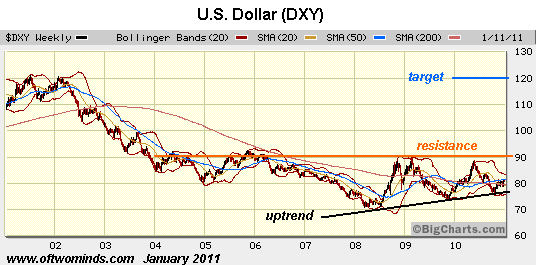Courtesy of Charles Hugh Smith, Of Two Minds
 Conventional wisdom is that the Fed wants the U.S. dollar lower, so it must drop. But the dollar seems to be lacking proper obedience to the Fed’s grand commands.
Conventional wisdom is that the Fed wants the U.S. dollar lower, so it must drop. But the dollar seems to be lacking proper obedience to the Fed’s grand commands.
Before you shout that all fiat currencies go to zero, let’s stipulate that the U.S. dollar has already proceeded 95% of the way to zero. According to the handy BLS inflation calculator, the 2010 dollar is roughly worth 4.5 cents of the 1913 dollar. Put another way, it now takes $22.10 to buy what $1 purchased in 1913.
(Interesting that the BLS inflation calculator only goes back to the birth of the Federal Reserve….)
So a 50% rise in the dollar would register as a mere blip on a 100-year chart. I mention this to put a 50% rise in perspective. It will seem like a large move in the present, but on a longer timeline it wouldn’t be that big a deal.
How could the dollar rise when the Treasury and Fed are moving Heaven and Earth to drive it down? Let’s turn to the Fed Flow of Funds for some perspective: what happened from 2007 (pre-recession) to the present?
Household Real Estate Assets: $22.7 trillion to $16.5 trillion: -$6.2 trillion
Corporate Equities: $9.6 trillion to $7.8 trillion: -$1.8 trillion
Mortgage debt: $10.53 trillion to $10.12 trillion: -$ .41 trillion
Household/non-profit Net Worth: $64.2 trillion to $54.9 trillion: -$9.3 trillion
And this is after a tremendous run-up in both bonds and stocks since early 2009. Add in whatever estimates of commercial real estate losses you reckon are semi-accurate and other impaired enterprise assets currently valued at "historical cost," i.e. marked to fantasy, and you get a number well north of $12 trillion even at conservative estimates.
The Fed has fought off this mass devaluation of assets by expanding its balance sheet by $2 trillion. First it sought to stem the collapse of the housing market by buying $1.2 trillion in impaired mortgage backed securities (taking garbage off the banks’ balance sheets) and now it is trying to suppress interest rates by buying $1 trillion in Treasury bonds (recall that QE1 already loaded the boat with T-Bills, so QE2 is simply adding another $600 billion to an already heavy cargo.)
In both cases the Fed’s campaigns are mere rear-guard actions: housing continues to slip, and the tides of higher yields and rates have started rising despite the Fed’s monumental, unprecedented intervention.
The losses in bonds and stocks have yet to register. If we look at global competition for cash to fund massive sovereign debt loads (roughly $10 trillion in 2011 alone), then a rise in yields from 3% to 5% would certainly fit into historical ranges.
So what happens to the value of current bonds when rates notch up from 3% to 5%? They take a 40% haircut. All existing bonds will be repriced so they too yield 5%. That means a $100 bond which is paying 3% will drop to $60 in order to match the 5% yield on newly issued bonds. (3% of $100 = $3, 5% of $60 = $3) That’s a 40% haircut for the bondholder.
What happens to the stock market when the Fed’s QE2 goosing runs out? What happens to current valuations which have priced in lofty expectations of profits going to the moon if profits disappoint?
It’s well within the range of possibility that both bond and stock markets will experience 25% declines as yields rise and profits fail to meet euphoric expectations. That would trigger another $5 trillion or so in losses.
Meanwhile, the vast debts denominated in dollars remain. This is a sketch of a scenario in which a mad rush for dollars ensues as assets decline in value and cash must be raised to pay down debt.
If you believe this is impossible, then take a look at a long-term chart of the U.S. Dollar Index (DXY).

Note that despite the Fed tossing spear after spear into the back of the dollar, it refuses to die. Rather than gracefully expire, the monster staggers on, gaining strength: that’s an uptrend, folks: there is no other possible intepretation of this simple chart of price.
It looks like the DXY is tracing out a long-term pennant or wedge, with price moving up and bouncing repeatedly off resistance around 90. The abrupt retreats could be interpreted as the result of frenzied intervention. If this wedge pattern holds, then price will compress into an increasingly tighter range and then explode upward once 92 is decisively breached.
Once the dollar breaks through the resistance band around 90-92, then the way is clear to re-test old support/resistance around 120–a 50% run-up from current levels.
Impossible! Perhaps–but then the global financial meltdown was also "impossible," as was the eurozone debt crisis, the Chinese housing bubble and so on. This chart is not saying a 50% rise in the DXY is impossible, but it’s also not predicting it will occur. We just have to open to the possibility.
Let’s see what happens at the 90-92 level before deciding what’s possible and impossible.
Pic credit: renjith krishnan at FreeDigitalPhotos


